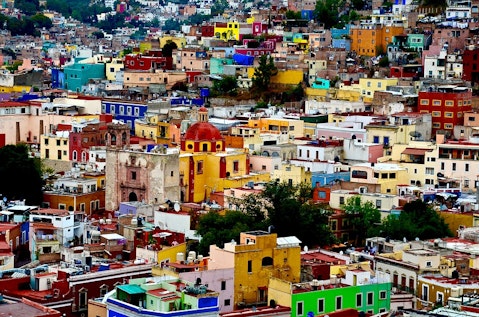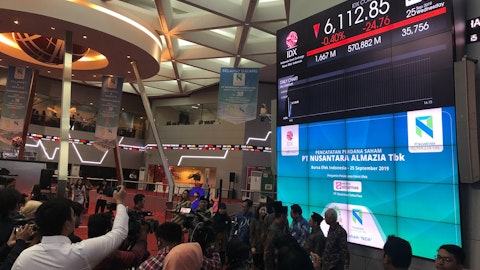In this article, we will take a detailed look at the 12 Most Advanced Countries in Latin America with insights into the Human Development Index (HDI) and Global Innovation Index (GII). You can skip our detailed intro and go directly to 5 Most Advanced Countries in Latin America.
Latin America has made significant progress in recent decades, with economic growth, poverty reduction, and improvements in education and healthcare. The region is also at the forefront of innovation in several areas, including renewable energy, fintech, and e-commerce. Latin America has a large young population of 156 million (between the ages of 15 and 29) and is increasingly connected to the global economy. This provides a large pool of potential customers and employees for tech companies. Latin America’s tech industry grew 5.6% in 2022, reaching $517 billion.
Furthermore, the loose economic policy worldwide and access to cheap capital during 2020 and 2021 boosted valuations and led to an unprecedented uptick in M&A (mergers and acquisitions) activity in the sector. This made it easier for U.S. investors to acquire or invest in Latin American tech companies.
In 2000, the United States was the largest goods trading partner for almost all countries in Latin America. However, the region has embraced multipolarity, with China emerging as a significant economic partner. Between 2000 and 2021, Latin America’s trade with China grew 28-fold, nearly twice the growth rate of trade with other emerging-market and middle-income economies. Despite this shift, the region has maintained growing trade ties with the United States, demonstrating its commitment to a diversified economic landscape.
A Look into Latin American Industry
Large companies are playing a vital role in boosting advancement in Latin America. They invest in new technologies and infrastructure, create jobs and training opportunities, support local businesses and suppliers, and promote social and environmental initiatives.
For instance, Mercado Libre (NASDAQ:MELI), the most extensive online commerce and payments ecosystem in Latin America, is well-positioned for future growth, with a net revenue of $10.5 billion in 2022.
Another Mexican multinational company, Coca Cola Femsa (NYSE:KOF) is a leading beverage, retail, and logistics company with a market cap of $16.13 billion.
Methodology
To rank the 12 most advanced countries in Latin America, we analyzed their Human Development Index and Global Innovation Index from UNDP and Global Innovation index.
As this was a subjective topic, we analyzed various web sources like Bloomberg Linea, World Population Review, and The Travel to ensure our rankings’ credibility. We also have analyzed numerous Reddit threads using relevant search terms such as “Most Advanced Countries in Latin America”, “Rich countries in Latin America” and “Highly developed countries in Latin America” to understand Reddit users’ opinions from sub-threads like r/asklatinamerica, r/askeconomics, r/urbanhell, and r/dataisbeautiful.
The first step in our ranking was based on the weighted averages of the above-mentioned criteria. To calculate the weighted averages, scoring has been done for all the above-mentioned indices based on the below weights:
- Human Development Index: 40%
- Global Innovation Index: 30%
- Web Sources: 20%
- Reddit Threads: 10%
By considering these specific weights of each metric, weighted averages are calculated that reflect the relative significance of each criterion. We then ranked the most advanced countries in Latin America in descending order from 12 to 1 (based on the weighted average results), with 1 representing the most advanced country and 12 representing the least advanced country on our list.
With these details in mind, below is our list of the 12 most advanced countries in Latin America.

Pixabay/Public Domain
Most Advanced Countries in Latin America
12. Ecuador
Human Development Index: 0.855
Ecuador, with a GDP of $115 billion and one of the steadiest growth rates in Latin America, is poised for continued success in its export commodities, including machinery, automotive parts/accessories, orthopedic, water resources, and telecommunications equipment. The Ecuador ICT market, valued at $4.45 billion in 2022, is expected to grow at a CAGR of 11.48% to reach $7.66 billion by 2027, presenting significant revenue opportunities for ICT providers. Ecuador has a diverse economy, exporting petroleum, bananas, coffee, rice, potatoes, sugarcane, cattle, sheep, pigs, beef, pork, dairy products, fish, shrimp, and balsa wood. The country also promotes itself as a tourist hotspot, leveraging its stunning biodiversity.
11. Colombia
Human Development Index: 0.752
Colombia, known for its salsa dancing, beautiful beaches, exotic fruit, and joyful people, is also a hotbed of innovation. One notable example is God Oil, an invention that won the 2019 Entrepreneurship World Cup and is now used to clean up oil spills. Another is the aerial robot for landmine detection, which was awarded the top prize in the reality contest “The Great Colombian Inventor.” The Colombian government’s commitment to innovation and advancement is evident in its allocation of a $339 million COP budget to science, technology, and innovation.
10. Dominican Republic
Human Development Index: 0.767
The Dominican Republic’s ICT sector has experienced significant growth in recent years, driven by the government’s Agenda Digital 20-30 strategy, which aims to raise national competitiveness, improve the standard of living, and make public administration more efficient and transparent. The surge in teleworking and the digitization of education has also boosted the use of computers and other IT services. The Dominican Republic also exports agricultural products such as sugar, bananas, and coffee. The Dominican Republic has a well-developed social welfare system, including universal healthcare and education. The country is also a leader in environmental protection.
9. Republic of Panama
Human Development Index: 0.805
Panama has significantly progressed in developing its national science, technology, and innovation (STI) system over the past 20 years. With a $60 million loan from the Inter-American Development Bank (IDB), Panama will promote the digital transformation of management and public services. The loan will support institutional strengthening of the digital innovation and cybersecurity ecosystem, including the design, construction, and launch of the Digital Government Innovation Hub.
8. Cuba
Human Development Index: 0.764
Cuba’s economy is diversified, with strengths in tourism, agriculture, and industry. The country is a major exporter of sugar, tobacco, and nickel. Cuba also has a well-developed healthcare system and a strong education system. Cuba’s GDP 2021 was $545.22 billion, accounting for 0.24% of the global economy. Science and technology parks are a new initiative to promote innovation in Cuba, already known as a regional education leader. It is also a popular tourist destination known for its beautiful beaches, colonial architecture, and vibrant culture.
7. Peru
Human Development Index: 0.762
Peru’s transformation over the past two decades has been remarkable despite significant challenges and risks. Poverty in Peru has fallen by over half nationally, to nearly 20%. The country has emerged as a strong and stable player in Latin America and a vital ally to the United States in a region facing new foreign policy challenges, such as the growing corruption scandals and the crisis in Venezuela. Peru is also a member of the Pacific Alliance, a trade block of four Latin American countries with strong economic growth. Peru’s economy is diversified, with mining, agriculture, and tourism strengths. The country is a significant copper, gold, and other minerals exporter. It is also a significant exporter of fruits, vegetables, and seafood.
6. Mexico
Human Development Index: 0.758
Mexico has shown financial resilience due to tighter global financial conditions and insufficient structural reforms. It has avoided a major financial crisis for nearly 30 years. As a G20 member, Mexico is committed to fostering close international cooperation on financial, technical, and environmental issues. The country is a key development partner of the German Federal Ministry for Economic Cooperation and Development (BMZ). The country is a significant exporter of oil, automobiles, and electronics. It is also a popular tourist destination for its stunning beaches, ancient ruins, and vibrant culture.
Click to continue reading and see the 5 Most Advanced Countries in Latin America.
Suggested Articles:
- 20 Most Socially Advanced Countries in the World
- 20 Most Advanced Countries in Africa
- Top 20 Most Technologically Advanced Countries in Europe
Disclosure. None. 12 Most Advanced Countries in Latin America is originally published on Insider Monkey.





